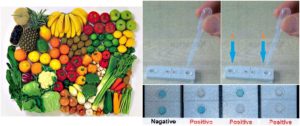How much pesticides and toxic heavy metals do your food and water contain? Are you and your family being chronically exposed to low levels of these toxicants? Is there any way to find out quickly, easily and affordably so that you can protect yourself and your loved ones?
From the end of the Second World War to the present time, the rate of cancer and neurological diseases such as depression, Parkinson’s and Alzheimer’s disease has risen steadily among the general population. This coincides with the significant increase in the ubiquitous use of pesticides over the same period. Exposure to pesticides even at chronically low levels has already been shown in various peer reviewed clinical studies to be linked to the occurrence of these diseases.
Now offers a means for you to monitor the safety of your food and water. As a result of a successful research program has developed a unique proprietary handheld rapid assay platform for the detection of pesticides and certain toxic heavy metals in food and drink. We offers three solutions for different level of users as shown above.
- One-step test with visual results in 5-8 minutes
- Test fruit and vegetables before consumption
- Significant risk reduction and cost savings
- One test for a large number of pesticides and toxic metals
- No interference with hot or soap- / baking soda- / alcohol- containing water
- Tailored wine testing kit available
EXAMPLES OF COMPOUNDS AND METALS DETECTED
| Acephate | Diazinon | Furadan/Carbofuran | Omethoate | Arsenic |
| Aldicarb | Dichlorvos | Isocarbophos | Phosmet | Cadmium |
| Aziniphos | Dicrotophos | Isofenphos-methyl | Phoxim/Valaxon | Copper |
| Cadusafos | Dimethoate | Malathion | Oxamyl | Lead |
| Carbaryl | Dipterex/Trichlorphon | Methamidophos | Mercury | |
| Carbosulfan/Methomyl | Ethyl Parathion | Methyl Parathion | Zinc | |
| Chloropyriphos | Fenamiphos | Monocrotophos |
Introduction
Pesticides are the quintessential double-edged swords of the chemical industry. Their widespread use in the last century has fueled the human race’s remarkable ability to produce enough food in abundance to keep pace with population growth that continually reduces available land for farming. It is estimated that (Pimentel et al.). However, such benefits come at a price. Their toxicity and persistence adversely affect human health, the environment, and the ability of future generations to maintain agricultural productivity and food safety.
It has been a half century since the publication of Rachel Carson’s “Silent Spring” and the birth of the environmental movement it spawned. Within a decade of the book’s release chlorinated hydrocarbons, represented by DDT, were taken off the agricultural market. As a result of the awareness of ecological issues this seminal book awakened, the use of pesticides has been brought under better control, the more dangerous agents have been outlawed by most countries, improved designs have rendered chemicals less toxic with faster biodegradability, and alternative non-synthetic chemical approaches have been developed such as biological control using natural pheromones to interfere with insect reproduction, microbial pesticides, and genetically modified pest resistant crops. However, the danger of toxic pesticides entering the food supply persists even to this day. The most recent well-publicized episode led to the deaths of 23 children in the Indian state of Bihar after they consumed a school lunch contaminated with the organophosphate insecticide monocrotophos.



Single Exposure versus Chronic Exposure
Allowable limits of pesticides in fruit, produce, water and beverages are predicated on the toxic effects attributable to a single event of exposure to the pesticide. These allowable limits are therefore set at levels much lower than those that can cause morbidity or death when a reasonable amount of that food or beverage is consumed by an adult at a single seating. Using these standards, regulatory agencies can rightfully claim that they have been successful in ensuring the safety of all we eat and drink even though pesticides continue to be found in detectable levels in these consumables. In 2013, the United States Department of Agriculture released the latest. showing that pesticides still contaminate fruits, produce, fish, and water, but the levels are much lower than the established limits.
Although these levels are considered safe, they are safe only insofar as a single exposure will not result in death or morbidity. Long-term chronic exposure to pesticides due to regular consumption of contaminated food and drink is rarely taken into consideration. Various studies have been published linking health problems with chronic exposure to pesticides. These include cancer, depression, neurological disease, and brain . Though some may argue that such risks are faced mostly by those chronically exposed to high levels of pesticide such as farmers, agricultural and chemical workers who come in daily contact with pesticides, there are common sense measures that can logically be taken to reduce the general public’s levels of chronic exposure.
Fruit and Vegetable vs. Drinking Water Limits
Additional caution is required when determining what levels of pesticide are safe since regulatory agencies differ from country to country in allowable levels and maximum tolerated levels are higher in food and produce compared to those for drinking water. For example, a study of pesticide levels in fruit-based drinks makes this point very clear: “The concentration levels detected (in drinks)* were of the micrograms per liter level, low when considering the European maximum residue levels (MRLs) set for fruits, but very high (i.e., 300 times) when considering the MRLs for drinking or bottled water.”
* parentheses added
Pesticides in the Wine Industry
Pesticides continue to be a concern for the wine industry. A random sampling and analysis of wines sold within the European Union performed in 2008 by the Pesticide Action Network (PAN) uncovered 34 of 34 conventional wine bottles contaminated with various pesticides at µg/L levels. Of 6 organic wines, one contained detectable levels of pesticide. Most of the pesticides found were synthetic fungicides, organophosphates and carbamates known to be carcinogens, developmental or reproductive toxins, neurotoxins, or endocrine disruptors.
The grapes used for these wines are the likely source of these pesticides as grape growers, who continue to use synthetic chemicals including carbamates and organophosphates to control mildew and insect pests, have no means to routinely determine if grapes contain pesticides prior to processing them into wine. The pesticide content of wine is undiscovered until tested as a final product by a regulatory agency. As a consequence, wine exporters have been forced to dump barrels of their product found to contain excessive levels of pesticide.
These economic losses can be avoided if there is an affordable and rapid method to detect pesticides at the beginning instead of at the end of the wine production process. Grapes can be qualified as having low or undetectable levels of pesticide prior to their conversion into wine. The issue of pesticides in wine can therefore be eliminated altogether by the employment of a rapid on-site test such as the G9 test to determine pesticide levels in grapes before actual wine production commences.
Pesticides in Fruit-Based Beverages
A similar problem exists in the juice and soft-drink industry. A similar study conducted by Spanish scientists in 2008 found pesticides in 100 fruit-based drinks from 15 different countries (Garcia-Reyes et al). They tested for pesticides such as carbendazim, thiabendazole, and imazalil, and malathion, which are applied to crops post harvest and can remain on fruits and vegetables during processing. They found relatively large concentrations of pesticides, in the micrograms per liter range, in most of the samples analyzed. This has raised concerns with the possible impact of chronic pesticide exposure on the health of children who regularly consume these drinks.
A recent news ABC news report uncovered similar levels of contamination in orange juice processed using fruit from Brazil.
The problem of pesticide contamination of fruit-based beverages can also be addressed at the beginning of the processing chain at the grower site by the employment of a rapid on-site test such as the G9Fast test to detect pesticide in fruit prior to beverage production.
Pesticides in Produce
Based on the USDA annual Pesticide Data Program Summary, the Environmental Working Group (EWG), a consumer health advocacy organization published their “Dirty dozen 2012 list of fruits and vegetables found to contain the highest levels of pesticides. They are listed below:
- Apples
- Celery
- Sweet bell peppers
- Peaches
- Strawberries
- Nectarines-imported
- Grapes
- Spinach
- Lettuce
- Cucumbers
- Blueberries
- Potatoes
- Green beans
- Kale/Greens
A Danish study reported in August 2013 that fruit and vegetables imported from other countries had higher levels of pesticides than local produce. Up to 82% of foreign fruit contained pesticides and 2.6% of foreign produce showed residue levels above the European Union’s maximum residue limits (MRLs).
Consumers and the agencies set up to protect them can use a rapid on-site test such as the G9Fast to screen produce destined for their tables for pesticides.
Effects of Pesticide Exposure on Human Health
Organophosphate and Carbamate pesticides are widely used due to their effectiveness in controlling insect pests that prey on fruit and vegetable crops. Bountiful harvests have a direct correlation with the well-managed use of these protective pesticides. However, exposure to high doses of these compounds can be toxic to humans and can cause in the short term death and severe illness. Long term chronic exposure can also lead to persistent health problems such as cancer, depression, and other diseases. Regulatory agencies such as the US Environmental Protection Agency (EPA) have enacted strict regulations that allow only very low levels of pesticide residues on the food that we eat. Nevertheless, enforcement can never be 100% and fruits, vegetables, and drink products imported from many foreign countries where pesticide use is not similarly well-regulated, increase the consumer’s risk.
Medically significant exposure to pesticides can be classified into high dose exposures and chronic low dose exposures. In the following sections, we discuss what happens when one suffers from each type of exposure.
High Dose Exposure
When one is exposed to high levels of pesticide near or above the human lethal concentration, the possible immediate effects are as follows:
- Nausea
- Loss of muscle control, convulsions, paralysis
- Uncontrolled urination and defecation
- Heart arrest
- Death
If the person survives the exposure, the symptoms subside within days or weeks with treatment. There is a very low probability that the average consumer may suffer such high dose exposure, although incidents such as the poisoning deaths of 22 schoolchildren in India in 2013 still occur where the lack of awareness and regulatory enforcement exists.
Chronic Low Dose Exposure
Observations in Laboratory Animals
Chronic exposure of laboratory animals to low, non-toxic doses of organophosphates have caused neuropathic disorders in laboratory animals (Ray and Richards, 2001). Therefore, even doses too low to produce any signs of the toxic effects of these compounds can affect the nervous system in the long term if the exposure is chronic.
Pesticides and Depression
Chronic low dose exposure to organophosphate pesticides has been linked to depression in humans. Several studies have revealed a strong correlation between chronic organophosphate pesticide exposure and anxiety and depression among pesticide applicators. Depression among spouses of applicators exposed to high doses of pesticide was significantly elevated as well.
Pesticides and Prenatal Development
Prenatal exposure to an organophosphate pesticide has been linked to abnormal brain development in children (Rauh et al, 2012).
Pesticides and Cancer
Low level chronic exposure to pesticides has also been associated with significant cancer risk and Organophosphates have been linked to leukemia and other immunologically related cancers.


